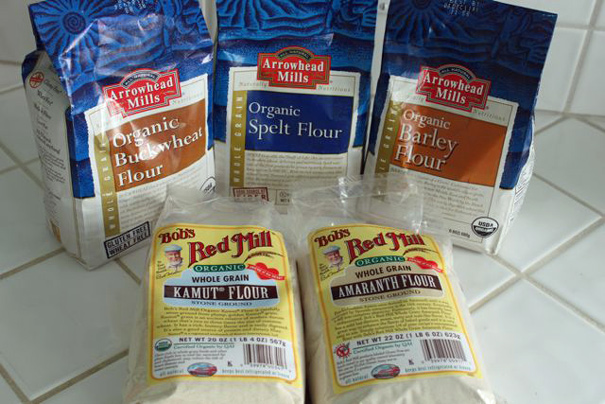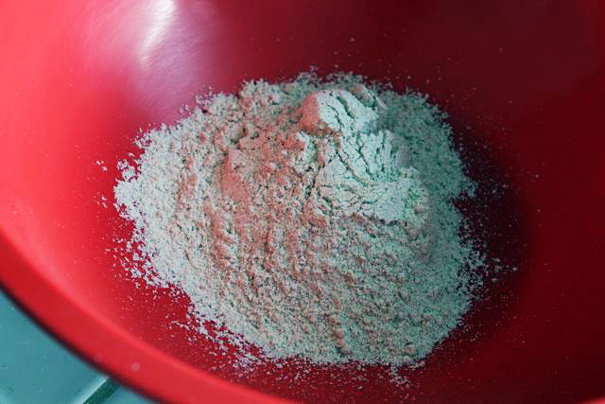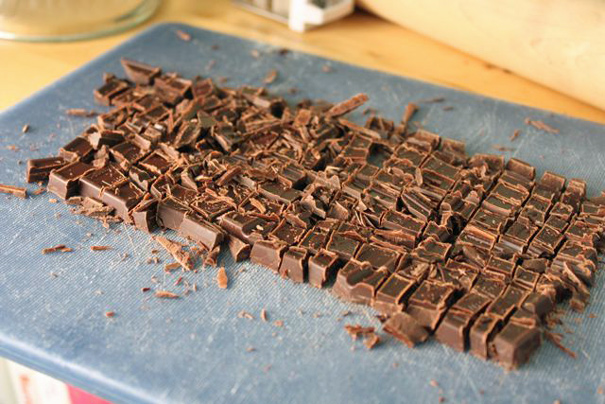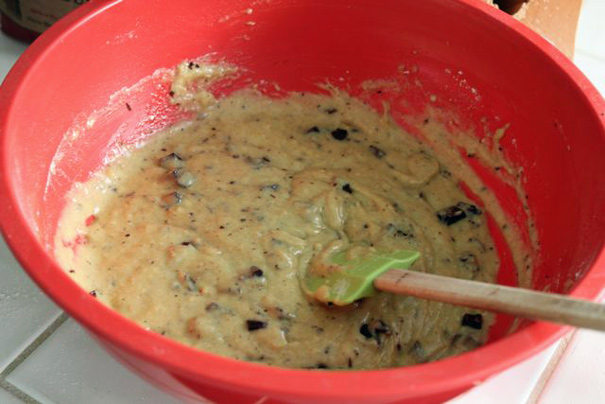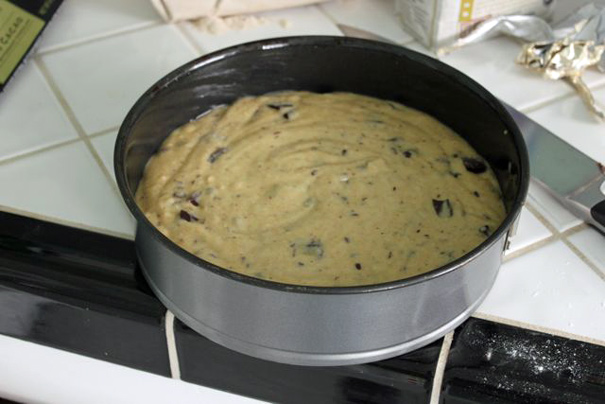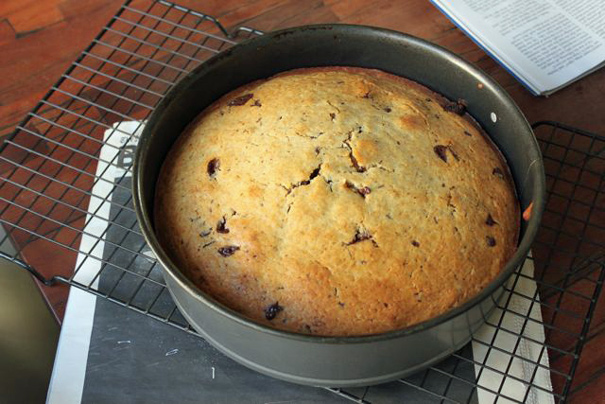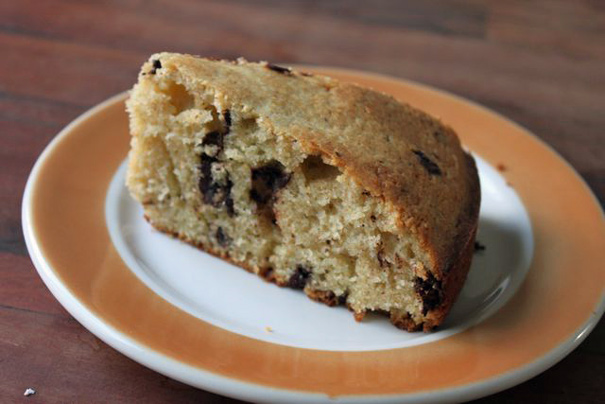Spelt & Olive Oil Cake with Bittersweet Chocolate
Spelt is not a pretty word. There's a reason that, when language was created, the word "love" became "love" and not "spelt." You can't imagine telling your life partner that you "spelt" him, can you? Let's all thank the language gods for that.
Unfortunately, we're left with the word "spelt" to describe a certain kind of flour that's been around, according to Kim Boyce and her excellent book "Good To The Grain", since "the Neolithic or Stone Age (circa 6000 B.C.E.), when wild or cultivated emmer mixed with indigenous wild grasses in the fertile area that is modern-day Iran."
Last week, on a whim, I decided that I'd had "Good To The Grain" sitting on my shelf for long enough and that, at long last, I was going to go to Whole Foods and buy up all the flours required to cook the recipes in this book. Now you don't have to buy them all at once--the book is organized by flour so if you just bought spelt flour or buckwheat flour, there'd be lots for you to make--but I wanted to create an arsenal of interesting flours to keep on hand for when the baking bug bites. Using non-white flours is a good idea health wise, anyway, and this book's recipes are so scrumptious-sounding I wouldn't feel like I'm missing out (plus, most of the recipes incorporate a little white flour anyway). Here are the flours I bought:
Those aren't all of the flours with chapters in the book (I also bought Whole Wheat flour, not pictured): there's also corn flour, multigrain flour, oat flour, quinoa flour, rye flour, and teff flour. But I figured these flours were a good place to start (and really, I didn't want to spend a small fortune at Whole Foods).
With all of these flours to choose from, I had plenty of options when I had a hankering for a sweet on Friday afternoon. After flipping through the various chapters, I settled on the olive oil cake made with spelt flour on pg. 172. Mostly because the recipe couldn't be easier. You mix together your dry ingredients:
(That's just the spelt flour by itself; then you add all-purpose flour, sugar, baking powder and salt.) Get your olive oil ready:
Mix it with eggs and milk and, if you have it, freshly chopped rosemary (I skipped that).
Stir the wet ingredients into the dry, add a bunch of chopped bittersweet chocolate:
And there's your batter. Boyce has you bake it in a tart pan, but I couldn't find mine so I used a springform pan which worked great:
That's a pretty remarkable treat for 5 minutes of work and 40 minutes of baking. As for the taste, it tastes best warm (as most baked things do) and, as for the flavor, the combination of the spelt and the olive oil gives the cake a uniquely grassy taste. It's as if a traditional yellow cake dropped out of society, joined a cult and lived in the woods for 10 years. Sure, there's something a little hippie dippy about it, but at the same time it's naughty enough to give you pleasure.
So, next time you're in Whole Foods, pick up some unusual flour, buy a copy of Kim Boyce's book and cook your heart out. You'll spelt it.
Recipe: Spelt and Olive Oil Cake with Bittersweet Chocolate
Summary: An easy afternoon cake from Kim Boyce's "Good To The Grain."
Ingredients
- Olive oil for the pan
- 3/4 cup spelt flour
- 1 1/2 cups all-purpose flour
- 3/4 cup sugar
- 1 1/2 teaspoons baking powder
- 3/4 teaspoon kosher salt
- 3 eggs
- 1 cup olive oil
- 3/4 cup whole milk
- 1 1/2 tablespoons fresh rosemary, finely chopped
- 5 ounces bittersweet chocolate (about 70 percent cacao), cut into roughly 1/2-inch pieces
Instructions
- Preheat the oven to 350 F. Coat a 9 1/2-inch fluted tart pan or a springform pan with olive oil.
- In a large bowl, either sift or whisk together the spelt flour, the all-purpose flour, the sugar, the baking powder and salt.
- In a large bowl, whisk the eggs thoroughly. Add the olive oil, milk, and rosemary and whisk again. Using a spatula, fold the wet ingredients into the dry ingredients just until combined. Stir in the chocolate then pour the batter into the pan, spreading it evenly and smoothing the top.
- Bake for about 40 minutes or until the top is golden brown and a skewer inserted in the center comes out clean. Let it cool on a rack for a few minutes then unmold it. You can eat it warm or store it, wrapped tightly in plastic, for up to 2 days.
Quick notes
This is a good afternoon snack cake; to dress it up for a dinner party, put some freshly whipped cream on top.
Variations
You can sub out the chocolate for another treat; dried fruit would work, as would nuts.
Preparation time: 10 minute(s)
Cooking time: 40 minute(s)
Number of servings (yield): 8
My rating


